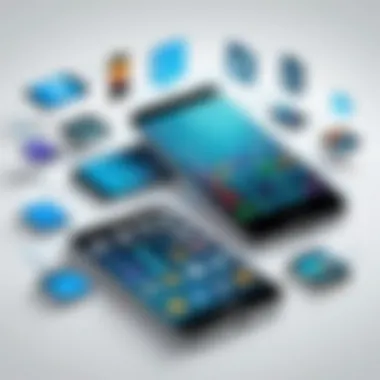The Unification of Phones: Exploring Technological Convergence


Intro
In today's tech-centric world, the humble phone has eclipsed its primary purpose of just making calls. Now, it serves as a hub for myriad functionalities, merging various technologies into one sleek device. This phenomenon is often referred to as the unification of phones—a fascinating journey that reshapes how we communicate and conduct business.
As we stroll down the historical lane, we notice how mobile technology has rapidly evolved over the last couple of decades. From basic cell phones with minimal features to today's powerful smartphones that include cameras, navigational tools, and an array of applications, the transformation is astounding. The convergence of diverse technologies into a single device is not just a trend; rather, it signifies a fundamental shift in user experiences and expectations.
In this article, we will dissect the implications of this convergence—what it means for both users and businesses alike. From the perspective of the consumer, a unified device offers unparalleled convenience, allowing for seamless interactions across multiple platforms. On the business side, as companies adapt their strategies to this new reality, the significance of understanding the market dynamics becomes increasingly crucial.
Let’s dive into the details and explore the fascinating landscape of unified phones, beginning with an overview of the latest technological research.
Preamble to Phone Unification
The surge in mobile technology over the past two decades can't be overstated. The evolution from basic cellular phones to the sophisticated smartphones we use today signals a monumental shift not only in the devices themselves but also in how we communicate, work, and live. This section dissects the importance of understanding hybrid functionalities in phones. As technological convergence continues to reshape the mobile landscape, grasping the nuances of phone unification becomes essential for anyone immersed in the tech industry or simply keen about gadgets.
Defining Phone Unification
Phone unification refers to the merging of various functionalities into a single handheld device. Traditionally, mobile phones served the primary purpose of calls and texting. Fast forward to today, and we have smartphones that act as mini-computers, cameras, gaming devices, and so much more. The distinction between a phone, tablet, or computer is increasingly hard to pin down.
Some key aspects of this unification include:
- Communication: Seamless interaction through voice, video, and messaging apps.
- Entertainment: Streaming services, games, and content creation tools bundled into one device.
- Productivity: Note-taking, calendar management, and project planning apps all integrated for efficiency.
One can't overlook how this phenomenon enhances user experience. As the saying goes, "jack of all trades, master of none" could easily be rephrased in the context of phones today. While they can do nearly anything, users expect them to excel in all areas. Thus, defining this unification is crucial for understanding consumer expectations and the technological landscape.
The Historical Context of Mobile Devices
To appreciate the current state of phone unification, it's vital to revisit the historical timeline of mobile devices. The journey began in the early 1980s with the introduction of bulky mobile phones that were not exactly pocket-sized. Those early devices laid the groundwork for what was to come, but they lacked the versatility we now take for granted.
The game changed in the late 1990s with the advent of the first smartphones, like the IBM Simon Personal Communicator. It featured touchscreen capabilities and a calendar, pioneering concepts that are foundational today.
Throughout the 2000s, mobile tech saw explosive growth. The introduction of Apple's iPhone in 2007 marked a critical point in this evolution, combining a phone, an iPod, and an internet communicator into one sleek device. Similarly, Google's Android platform opened the floodgates for scores of manufacturers to innovate and compete.
This historical context helps frame phone unification not just as a technical innovation, but as a societal shift. We transitioned from merely using phones for communication to relying on them for nearly every aspect of our daily lives. The timeline demonstrates the natural progression toward a unified device, showcasing the thought processes and market movements that propelled this transformation forward.
The narrative of mobile technology is one of continual adaptation, where dysfunctions are mended and new functionalities emerge, often driven by consumer demand.
In summary, understanding the historical context enriches our insight into how and why phone unification came to be. It's not just about trends; it's about the evolving relationship between technology and the individual. By connecting these historical dots, we gain a clearer vision of the future as we navigate the complexities of unified communication devices.
Technological Influences on Unification
The unification of phones is not an arbitrary or random evolution; it's profoundly tied to the advancements in technology that shape our everyday lives. Understanding these influences is essential for grasping how mobile devices have transformed beyond mere communication tools into multifunctional platforms that cater to a swath of consumer needs. In this section, we will delve into three pivotal elements that have driven this convergence: the rise of smartphones, the integration of internet capabilities, and the role of app ecosystems. Each of these factors plays a significant role in redefining what we expect from our devices and how they fit into our individual and professional lives.
The Rise of Smartphones


Smartphones are often hailed as the spearhead of technological unification in the mobile domain. Unlike their predecessors, they are not merely devices for voice calls. They amalgamate various functionalities, from texting and satellite navigation to photo and video capabilities all folded into a single sleek package.
The introduction of iPhone in 2007 is a pivotal moment in this journey. It offered a user interface that was both intuitive and attractive, which in turn ignited the smartphone revolution. Companies like Samsung, Google, and Huawei quickly followed suit, introducing their own powerful versions. The ability to access high-quality cameras and advanced computing power on a handheld device marks a significant turning point in mobile tech history.
"Smartphones are less about calling than about connection, a bridge to countless experiences in our busy lives."
A smartphone is now our camera, our GPS, our music player, and much more. They have become indispensable for everything from social interactions to business transactions. As such, demand for these devices has escalated, prompting manufacturers to innovate even more.
Integration of Internet Capabilities
The internet has irrevocably changed how we live and communicate. When integration started to occur on mobile devices, it brought an avalanche of apps and services directly to our pockets. More than just a means of browsing, internet capabilities turned phones into gateways to information and services at our fingertips.
Imagine the shift—once upon a time, if you needed to know something, you’d flip through a yellowed encyclopedia or call someone for insights. Now, it's a matter of seconds to look it up online or chat with someone across the globe. This leap has reshaped user expectations: a premium smartphone today demands fast processing speeds and seamless connectivity, qualities once considered luxuries.
Such capabilities also raised new questions around issues like data privacy and cybersecurity—a discussion that's more relevant today than ever before. Users now expect not only connectivity but security as well, creating a dual demand that influences both manufacturers and software developers.
The Role of App Ecosystems
Apps are the lifeblood of unified phone functionality. They allow users to personalize their devices and tailor them to their unique needs. The app ecosystem is not just crowded; it’s vital to the user experience—offering everything from productivity tools to social media platforms and health monitors.
Major players like Apple and Google have cultivated vast app marketplaces—Apple's App Store and Google Play—which serve as hubs for this thriving ecosystem. These platforms have fundamentally altered how software is delivered and monetized, and they've enabled independent developers to reach vast audiences with relative ease.
However, with great power comes great responsibility. Users are often overwhelmed by choice, and companies face pressure to ensure quality—safeguarding user experience while innovating effectively. Holistic development is crucial; the era of haphazard apps is gradually fading, giving way to sophisticated, user-friendly solutions that enrich our daily lives.
As we move further into this confluence of technology, the phones we use will likely continue to evolve, intertwining even deeper with our personal and professional ecosystems. Uncovering these dynamics allows us to better anticipate how future innovations may reshape the landscape once again.
User Experience in a Unified Phone World
With the rapid evolution of mobile technology, how users interact with their devices has fundamentally reshaped the landscape of communication. User experience in a unified phone world is more than just a buzzword; it often dictates whether a technology succeeds or fails in the marketplace. In this context, the merging of various functionalities into smartphones results in exceptional benefits but also important considerations that warrant careful exploration.
Streamlined Communication
In today's fast-paced world, the desire for efficiency is stronger than ever. Unified phones consolidate multiple communication avenues—text, calls, video chats—into a single device. This integration allows for smoother interactions. Imagine a scenario where a user can shift seamlessly from a voice call to a quick text message without losing context. This capability not only saves time but enhances the user's emotional connection when communicating. Additionally, having all communication tools in one place encourages spontaneous interactions, leading to more robust relationships, both personal and professional.
Moreover, smartphones leverage cloud technologies that enable message synchronization across devices. If an individual starts a conversation on their tablet, they can pick it up on their phone precisely where they left off. This continuity heightens the user experience; no one wants to juggle between multiple devices and apps when a single solution exists.
The Impact on Daily Interactions
Unified phones have revolutionized how people engage daily. From one-click dialling to integrating features like social media updates into user interfaces, phones have become extensions of our lives. Users can check their work emails while commuting, stay updated with friends' activities, or manage daily tasks all from one device.
It reshapes not just personal time but professional environments too. Team members can collaborate on projects through shared applications, making meetings more focused and productive. Interactions are faster, richer, and often enhanced by the immediate sharing of information. Increased connectivity also means work-life boundaries can blur, which merits attention—balancing this aspect remains vital for user well-being.
Addressing User Privacy Concerns
While the benefits of unified communication devices are apparent, they come with pressing user privacy concerns. As smartphones gather vast amounts of personal data, the potential for breaches or misuse is ever-present. Users today are more aware of how their information is used, raising questions about data security in a largely connected environment.


"In a world where every tap can leave a digital footprint, privacy is no longer just a feature; it's a necessity."
To navigate these waters effectively, manufacturers must prioritize transparency in data usage policies. People appreciate knowing how their data is handled and deserve control over their privacy settings. The ability to manage permissions directly from the device enhances user trust. Moreover, educating users on tools such as encryption and two-factor authentication can empower them to take charge of their digital lives.
In summary, user experience in a unified phone world intertwines convenience with responsibility. The balance between effective communication, enhanced daily interactions, and vigilant user privacy is crucial in shaping the future of mobile devices. As technology continues to evolve, the dialogue surrounding user experience will certainly remain a pivotal part of discussions in this industry.
Market Dynamics and Business Strategies
The market dynamics surrounding the unification of phones represent a pivotal shift in how communication devices are perceived and utilized in everyday life. As technology marches forward, consumers increasingly demand devices that are not just functional, but also seamlessly integrated into their various lifestyles. This growing expectation pushes businesses to rethink their strategies, leading to an evolving interplay between consumer behavior and business initiatives.
The significance of understanding market dynamics in this context can't be overstated. It shapes everything from product design to pricing strategies. Companies must now cater not just to user needs, but also anticipate trends that could affect sales and market positioning. The benefits of grasping these dynamics include improved forecasting, enhanced user satisfaction, and the ability to drive innovation.
Emerging Business Models from Unification
As phones adapt to merge multiple functionalities — including telecommunications, gaming, photography, and even financial services — a new wave of business models has begun to surface. The emergence of subscription-based services is one notable model. Instead of a one-time purchase, customers may opt into plans that encompass hardware, software, and essential updates all in one. Devices become less about ownership and more about continuous engagement.
Some other relevant models include:
- Freemium Services: Basic features are available for free, with premium options through subscriptions.
- Ecosystem Integration: Companies build interconnected devices and software that provide an immersive user experience.
- Partnerships with Content Providers: Devices bundled with exclusive content offerings to entice users (think of Spotify links with premium smartphone sales).
These models illustrate how companies leverage tech convergence to foster ongoing relationships with consumers, ensuring they stay relevant and in demand.
Challenges for Traditional Phone Manufacturers
While the unification of phone technologies presents opportunities, it doesn't come without its set of challenges. Traditional manufacturers are often caught in a turbulent sea as they navigate consumer expectations and disruptive competitors. Companies accustomed to pioneering the industry are now compelled to innovate at an accelerated pace. Failure to adapt can mean losing precious market share.
Some hurdles include:
- Rapid Technological Advancements: Keeping pace with innovations becomes increasingly complex.
- Competition from Non-Traditional Players: Brands from other sectors, like tech companies or automotive manufacturers, are elbowing their way in.
- Supply Chain Disruptions: Global events can heavily impact sourcing materials and production timelines.
- Changing Consumer Preferences: Manufacturers have to acknowledge that consumers prioritize features differently now, as they look for more holistic devices.
These challenges compel traditional manufacturers to pivot their strategies, driving them to rethink their R&D efforts and engage in more calculated marketing.
Strategic Partnerships and Collaborations
In this fast-evolving landscape, forming strategic partnerships has become essential for success. Businesses now realize that collaboration often yields the best solutions. By aligning with other companies in complementary spaces, they can enhance their offerings while also sharing risks and rewards.
Common types of collaborations include:
- Tech Collaborations: Component manufacturers partnering with software developers for better integration.
- Cross-Industry Partnerships: For instance, a phone manufacturer working alongside financial services to offer mobile payment solutions.
- Joint Ventures: Two or more companies pooling resources to create a new technology, tapping into each other's strengths.
These partnerships can catalyze innovation, reduce time to market, and foster a more versatile product lineup. By leveraging external expertise, companies can better respond to emerging trends and consumer demands, making them more competitive in a unified marketplace.
"In a landscape where the lines blur between functionalities, collaboration is no longer an optional strategy; it's a necessity for survival."
In essence, navigating the market dynamics of phone unification demands a multifaceted approach. Companies must innovate, adapt, and collaborate to thrive amidst the escalating complexities of the tech landscape.


The Future of Unified Communication Devices
The trajectory of unified communication devices carries significance beyond mere technological novelty. It's about how these devices reshape our interactions and influence our daily lives. It signals a merging of features that give rise to devices that are not just phones but essentially, Swiss Army knives of communication. The modern consumer's appetite for convenience and multifunctionality sets forth a wave of change that traditional phone designs are currently striving to meet.
Innovations on the Horizon
As we peer into the crystal ball of future innovations, several developments stand out on the horizon. Emerging technologies like 5G connectivity are set to enhance the speed and capability of mobile devices, allowing for seamless streaming and real-time communication without lag. Furthermore, advancements in AI and machine learning will enable phones to adapt to user behavior, personalizing user experiences in unprecedented ways. Imagine a device that learns your communication patterns, suggesting the best times to reach out to certain contacts or reminding you of previous conversations relevant to upcoming discussions.
Additionally, with the rise of augmented reality (AR) and virtual reality (VR), phones will likely take on new roles, blurring the lines between the digital and physical worlds. Picture a scenario where your phone can project a virtual meeting environment right in your living room, creating an immersive experience that flattens the barriers of distance.
"Technology is best when it brings people together. The future of unified communication devices promises to do just that, evolving to meet our social and professional needs."
Potential Shifts in Consumer Behavior
With these innovations come shifts in consumer behavior that are tangible and impactful. As users become accustomed to more integrated solutions, expectations will shift toward devices that not only unify communication but elevate it. The demand for more comprehensive and user-friendly solutions will push manufacturers to rethink design and functionality.
A trend towards sustainability is also gaining traction. Consumers are becoming more conscientious about the devices they choose. This shift could lead to a rise in demand for modular or repairable devices, that allow for easy upgrades and reduced electronic waste. More and more users might opt for brands that support ethical manufacturing practices or those that facilitate long-term usability.
Another important aspect is the increasing reliance on devices for remote collaboration. The surge in remote work triggered by global events has normalized virtual interactions. This change in workstyle might make features like video conferencing, group chats, and real-time collaboration tools even more central to how we utilize unified communication devices.
Global Trends Influencing Phone Technologies
Global trends are fundamentally reshaping the landscape of phone technologies. The need for universal connectivity drives innovation. The growing emphasis on a connected world means that devices must conform to greater interoperability standards.
Emerging markets are also becoming vital players in this arena. As countries in Asia and Africa rapidly expand their mobile infrastructures, the expectations for affordable, multifunctioning devices that cater to local needs are rising. Companies that position themselves to meet these market dynamics may discover lucrative opportunities.
Additionally, the shift towards privacy and data security becomes crucial in this conversation. There’s a heightened awareness among users regarding how their data is handled, pushing manufacturers to prioritise enhanced security features. Compliance with regulations, such as the General Data Protection Regulation (GDPR) in Europe, sets a benchmark for privacy standards globally and shapes consumers' purchasing decisions.
Finale: Assessing the Impact of Unification
As we bring this extensive discussion to a close, it becomes essential to assess the multifaceted impact that the unification of phones has on both consumers and the tech industry. The crux of this exploration lies in understanding how converged mobile functionalities influence daily interactions, business strategies, and future technological advancements. With every tick of innovation, this landscape morphs, and recognizing its importance cannot be overstated.
The unification creates not just a singular communication device but a central hub of activities – from messaging and browsing to gaming and productivity applications. This convergence not only adds convenience but also reshapes the very core of how users interact with technology and each other.
Synthesizing Key Insights
The key insights arising from this journey through the unification narrative can be encapsulated as follows:
- User-Centric Design: Unified technologies enhance user experience by streamlining tasks into fewer devices. Instead of juggling multiple tools — phones, tablets, computers — a single device can suffice for various purposes.
- Increased Functionality: With the integration of features, we witness an escalation in capability. Phones are no longer merely communication tools; they serve as cameras, wallets, and even fitness trackers.
- Privacy and Security: While merging functionalities brings convenience, it raises pressing concerns about data security and user privacy that cannot be ignored. As more digital footprints are left across applications, the importance of robust privacy measures escalates dramatically.
- Market Adaptation: Traditional manufacturers face intense pressure to innovate continuously, as user expectations align with the capabilities of these multifunctional devices. This push often results in rapid adaptation to new trends, enhancing competition and innovation.
In summary, the convergence of phone functionalities reflects a vital shift in consumer expectations and technological possibilities. Keeping a keen eye on these insights can help both users and businesses navigate this changing landscape.
Final Thoughts on Technological Convergence
Looking ahead, it's clear that technological convergence is not merely a passing phase; it is an ongoing evolution. As innovation continues to race forward, phones will increasingly morph to embody features yet to be fully imagined. Potential developments could usher in even greater integration of AI, augmented reality, and IoT capabilities into handheld devices.
"The future belongs to those who believe in the beauty of their dreams."
Delving into technology's future requires imagination, and imagination will yield a roadmap for thriving in an interconnected digital realm.
Individuals and businesses alike must actively adapt to these changes. Embracing this comprehensive, unified approach can provide significant competitive advantages, leading to better-informed decisions and enhanced experiences in this digital age. Understanding this growing convergence ultimately positions all of us to leverage its benefits more effectively in our daily lives and business strategies.
The road ahead is as exciting as it is unpredictable. What remains clear is that the unification of phones is just the beginning of a much larger trend toward integrated communication and technology. We stand at the threshold of a remarkable era, and readiness to embrace this convergence will define the road ahead.







